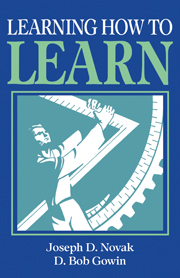Book contents
- Frontmatter
- Contents
- Foreword
- Preface
- Acknowledgments
- 1 Learning about learning
- 2 Concept mapping for meaningful learning
- 3 The Vee heuristic for understanding knowledge and knowledge production
- 4 New strategies for instructional planning
- 5 New strategies for evaluation: concept mapping
- 6 The use of the Vee for evaluation
- 7 The interview as an evaluation tool
- 8 Improving educational research
- Appendixes
- References
- Index
7 - The interview as an evaluation tool
Published online by Cambridge University Press: 05 June 2012
- Frontmatter
- Contents
- Foreword
- Preface
- Acknowledgments
- 1 Learning about learning
- 2 Concept mapping for meaningful learning
- 3 The Vee heuristic for understanding knowledge and knowledge production
- 4 New strategies for instructional planning
- 5 New strategies for evaluation: concept mapping
- 6 The use of the Vee for evaluation
- 7 The interview as an evaluation tool
- 8 Improving educational research
- Appendixes
- References
- Index
Summary
THE INTERVIEW
The origins of the interview go back to the nineteenth-century work of psychoanalysts, although forms of systematic questioning were used in early Greek and Roman times, or before. It was largely Jean Piaget and his colleagues in Switzerland, however, who perfected the interview as a tool for assessing cognitive capabilities in the 1920s and 1930s, and it is to Piaget and his coworkers that we owe the development of interview strategies for use with children.
Piaget's approach was to present very carefully selected specific objects or events to children and to ask carefully worded specific questions. As the tasks and questions were developed over time, Piaget found that the responses of children in selected age ranges could be characterized into a small set of groups, or stages. The relatively high degree of predictability of children's responses in these interviews provided support for Piagct's theory of cognitive development, which was widely used in the United States in the 1960s and 1970s to explain why students failed at certain learning tasks.
Piaget's theory, and associated interview methods for making records of children's reasoning, led to the observation of four stages of development: (1) sensory motor (prereasoning responses, ages o to 2), (2) preoperational responses (interpretations of tangible objects or events on the basis of manifest attributes as perceived by the child, ages 2 to 7), (3) concrete operational responses (responses based on reasoning, but only about manifest attributes, ages 7 to 14), and (4) formal reasoning responses (“abstract” thinking about objects or events, ages 14 and above).
Information
- Type
- Chapter
- Information
- Learning How to Learn , pp. 119 - 148Publisher: Cambridge University PressPrint publication year: 1984
